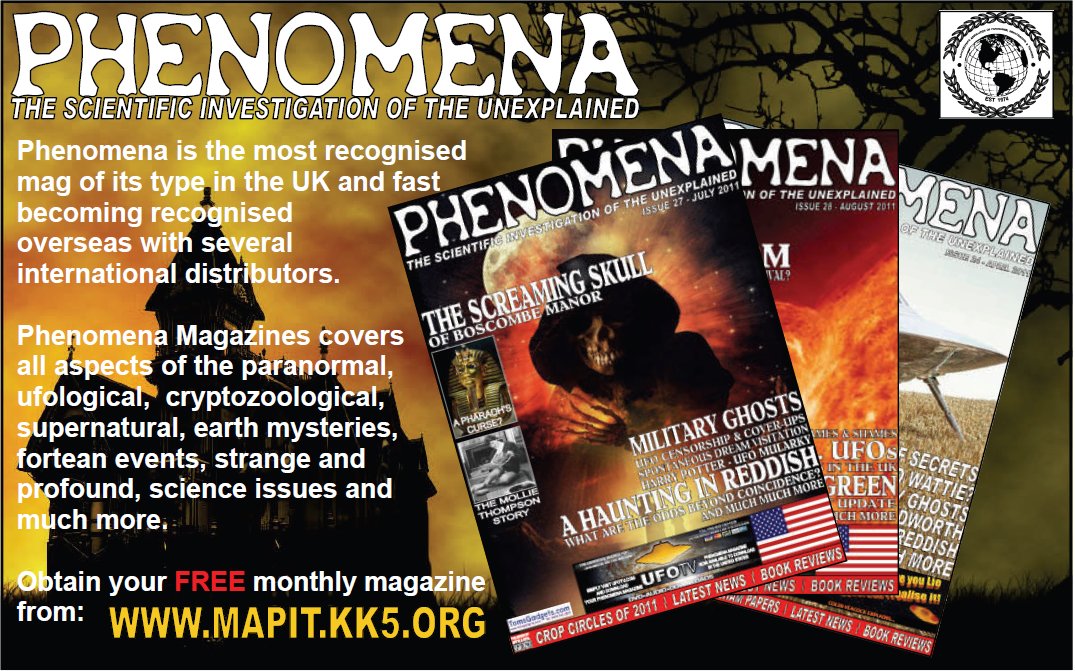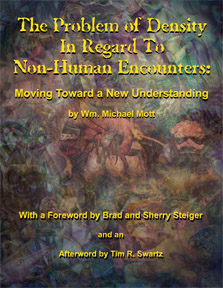Who knows what evil lurks in
the hearts of men? Is it the CIA?
Is it the NSA? Is it the extraterrestrials who hover over
your house late at night? Is it the Men-In-Black who are sitting
outside your home in their black cars watching your every activity?
Well don't worry. They aren't interested in you...they are
just waiting for another exciting issue of their favorite weekly,
newsletter of conspiracies, UFOs, the paranormal and everything else
weird and strange -- CONSPIRACY
JOURNAL!
- Aliens May be Out There, but Too Distant for Contact -
- Gifts From The 'Furry Folk'
-
- Ancient Egypt Illuminated by Electricity? -
AND: Meet Issie, Japan’s Very Own Loch Ness Monster
All these exciting stories and MORE in this week's
issue of
CONSPIRACY JOURNAL!
~ And Now, On With The Show! ~
JUST OUT .
. . SPECIAL ON LINE EDITION OF THE
CONSPIRACY JOURNAL --- MORE COLOR, MORE PAGES
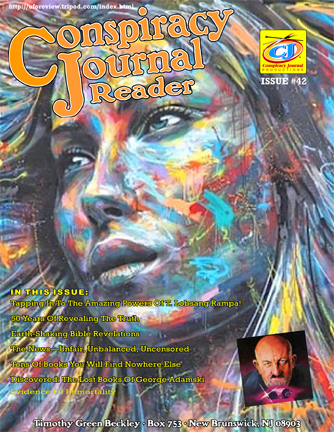 Here is a
direct link to Issue # 42
Here is a
direct link to Issue # 42
http://therealmidori.com/CJ-42.pdf
Order Now
Thru PayPal or Credit Card and we will discount your
order by 15%. E Mail us at mrufo8@hotmail.com and we will
send you a PayPal invoice. Credit Card
hotline
is 732 602-3407 . . .either leave an order or we can
call you back, but you must answer.
And be
sure to visit our YouTube site for FREE video
interviews.
MrUFOs
Secret Files
https://www.youtube.com/results?search_query=mr+ufos+secret+files
And Please Have A Wonderful Summer
Timothy Beckley, Publisher
PS: Your invited to join Tim Swartz and
Mike Mott every Sunday at Midnight for fabulousguests.
Just go to theouteredge.com
on almost any internet device. Tim
Beckleyco-hosts the Sunday of every
month. Paranormal radio like you've never heard
it before.
Coming At You From Conspiracy
Journal

Two Book Houdini Special
Get This Amazing Deal Before It Vanishes Before Your Very Eyes!
The
History Channel recently rewrote the life of Harry Houdini. Here,
Conspiracy Journal sets the record straight with two amazing books
containing the research of both Houdini and the creator of Sherlock
Holmes, Sir Arthur Conan Doyle. Revealing The Bizarre Powers of Harry Houdini
and
The Paranormal World of Sherlock Holmes
Was
Harry Houdini a closet Psychic? Clairvoyant? Or Spirit Medium?
His friend Sir Arthur Conan Doyle insisted he had the evidence that the
world's greatest escape artist was not the skeptic he made himself out
to be. At his burial some curious and suggestive words were
used by the presiding rabbi: "HOUDINI POSSESSED A WONDROUS POWER THAT
HE NEVER UNDERSTOOD AND WHICH HE NEVER REVEALED TO ANYONE IN LIFE! The
creator of Sherlock Holes, Sir Arthur Conan Doyle, and Harry Houdini
were strange bedfellows. Doyle was a contemporary of the world's
greatest magician and escape artist, who continually battled his friend
over the legitimacy of life after death, and the reality of
spiritualism. Doyle was a "true believer," while Houdini made it his
"mission" to denounce just about all things preternatural. . . Doyle
was convinced - from what he personally witnessed and what others
confided to him - that Houdini could read minds, dematerialize,
possessed supernatural strength, and was guided by angelic forces which
shielded him from harm even during the most dangerous of escape
performances which likely would have caused death to others. Doyle
stated that Houdini had once remarked, "There are some of my feats
which my own wife does not know the secret of." And a famous Chinese
conjurer who had seen Houdini perform added, "This is not a trick, it
is a gift." Sadly, many of Houdini's feats died with him, even
though they would have been an invaluable asset. "What can cover all
these facts," states Doyle, "save that there was some element in his
power which was peculiar to himself, that could only point to a psychic
element -- in a word, that he was a medium." Here, is both
sides of the story -- in the actual words of the famed Sherlock Holmes
originator and Houdini himself, who went out of his way to create the
impression that fakes and phonies were afoot everywhere in the "shady
world" of table tapping, levitating trumpets, spirit photography, slate
writing, as well as the materialization of ectoplasmic forms in the
darkening shadows of the séance room.
You can also phone in
your credit card orders to Global Communications
24-hour hotline: 732-602-3407
And as always you can
send a check or money order to:
Global Communications
P.O. Box 753
New Brunswick, NJ 08903 Please make out checks to: Timothy Green Beckley
- JUST LEAVE A MESSAGE DEPARTMENT -Aliens May be Out There, but Too Distant for ContactBy Irene Klotz  The
Milky Way may be home to some 3,000 extraterrestrial civilizations but
the vast distances between our galactic cousins will make contact
extremely rare, a new study concludes. Data collected by NASA’s
Kepler space telescope and other observatories scouting for planets
beyond the solar system indicate Earth is one of some 40 billion
potentially habitable worlds in the galaxy, with about one new
life-friendly planet forming every year, astronomer Michael Garrett,
head of the Dutch astronomy research foundation ASTRON, said at the
International Astronomical Congress in Toronto. Sounds
promising, until you consider the sheer size of the Milky Way, which
spans more than 100,000 light-years in diameter. Light travels at about
186,000 miles per second, but a signal will still take more than 4
years to reach neighboring system Alpha Centauri and 100,000 years to
travel from one end of the galaxy to the other. “On average,
you’d expect the civilizations to be separated by at least 1,000
light-years in the Milky Way. That’s a large distance, and for
communication purposes you need to allow for twice the travel distance,
so you’re talking about civilizations that have to be around for at
least a few thousand years in order to have the opportunity to talk to
each other,” Garrett said. “We don’t really know the time scales in which civilizations persist,” he added. The
one example available -- Earth -- indicates that life essentially
developed as soon as the conditions were right, but intelligent life
arose comparatively late. “It’s really just essentially in the
last few minutes of the overall evolution of life on the planet,"
Garrett said. "I don’t want to be too negative about this, but ... my
basic conclusion is that SETI signals will be rare in the Milky Way." That
doesn’t mean astronomers shouldn’t look, he added. Quite the contrary,
given the huge technological leaps in radio astronomy and in data
processing techniques compared to what was available for Search for
Extraterrestrial Intelligence, or SETI, programs 60 years ago. SETI
also is benefitting from sister radio astronomy projects, such as the
ongoing quest to find the source of mysterious transient radio bursts. “SETI
is not easy, but it’s a pursuit that is well worth doing. The question
is so important,” Garrett said. “Everyone is interested, not just
scientists and space enthusiasts. People in the street are interested
to know what else is out there.” Source: Discovery http://news.discovery.com/space/alien-life-exoplanets/aliens-may-be-out-there-but-too- distant-for-contact-141002.htm
- CRYPTO FOUR CORNERS DEPARTMENT -
Gifts From The 'Furry Folk'

JC
Johnson and some of the Crypto Four Corners team, Leonard Dan &
Jack Cary, were interviewing Gerald Bringle, a geologist & Bigfoot
enthusiast. He had previously accompanied JC and the team at their
study site in the Chuska Mts. of New Mexico. Gerald was recalling an
earlier expedition, in the Bradshaw Mountains of Arizona (Prescott
National Forest) along the Burro Creek. This location is approximately
50 miles northwest of Phoenix. Gerald explained that he enjoyed
swimming in the evening, and that there was a swimming hole in the
creek behind his campsite. He used a game trail that gave him access to
the creek. He noticed a huge free-standing rock along the trail, which
he remarked was unusual. He continued towards the swimming hole. When
he was finished swimming, we walked back towards his campsite. When he
approached the huge rock, he noticed a handful of red mesquite beans
laying on it. This particular species of mesquite beans are not easy to
find according to JC. Gerald thought that this may be a ‘gifting’
situation with one or more of the local Bigfoot or ‘Furry Ones,’ so he
replaced the mesquite beans with several glass marbles. He continued
walking toward his campsite. The next morning he decided to go
swimming, and as he approached the huge rock he noticed that the
marbles were gone and in their place was a small blue pastel rock
(possibly Arizona Blue Agate). Gerald replaced the small rock with
trinkets and beads. Once again, when he returned he found another
‘gift.’ This back and forth exchanged continued for several days.
Gerald offered more trinkets as well as a large coffee can of fruit.
Each exchange yielded several interesting stones & objects of
different shapes and designs. These included a Black Obsidian arrowhead
crafted by earlier native people, shaped Hematite & Serpentine and
a sea-bean (drift seed). Then, finally, a remarkable artifact
was presented to Gerald. The piece is a circular White & Black
Agate medallion, carved with a distinctive ‘eye’ design on one side and
an effigy of a deity on the other. It is similar, in design, to a
Chinese lion or dragon…but it is not jade. JC contacted me about the
piece in order to identify the markings. After some research, I
determined that the piece may have been a talisman used by the Anasazi
people. I had found depictions of original pieces and compared the
markings. The Anasazi or Ancient Pueblo Peoples were an ancient Native
American culture in what is now the southwestern United States. The
word Anasazi or Anaasází is Navajo for “Ancient Ones” or “Ancient
Enemy” and these people farmed the Four Corners area between 900 AD –
1300 AD. There has been speculation that this and other
artifacts may be part of a larger stash. This particular piece seems to
have minimal wear on it, possibly remaining in one place for a
significant amount of time. Is it possible that the Bigfoot population
has access to these artifacts? Further information on this artifact is
welcomed. In the second part of the video, JC, Leonard and Jack
return to an area near Crownpoint, New Mexico where they previously
investigated a ‘Furry One’ track line. It was apparent that others had
been coming back into the area. You can read about the investigation at
– Crypto 4 Corners Investigates ‘Furry One’ Track Line. Leonard had
talked to one of the residents, who recalled a rather unusual account
of a small ‘Furry One’ outrunning family members on horseback. Another
local rancher named Jonathan detailed an encounter where a dark being
on four legs was seen sneaking up on birthing cattle in an attempt to
steal the newborn. When confronted, this dark being stood up on two
legs and quickly ran away. Watch the video - Video Interview With Gerald Bringle - Gifting from the Furry FolksSource: Phantoms and Monsters http://www.phantomsandmonsters.com/2014/10/crypto-four-corners- gifts-from-furry.html
- IT'S A WHOLE WIDE WORLD OF COLOR DEPARTMENT -The Women With Superhuman Vision
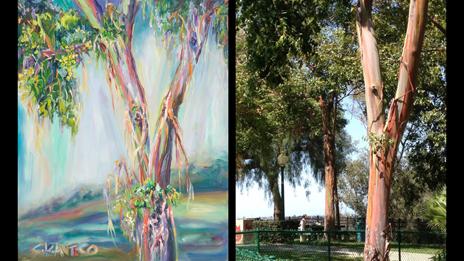 As
Concetta Antico took her pupils to the park for an art lesson, she
would often question them about the many shades she saw flashing before
her eyes. “I’d say, ‘Look at the light on the water – can you see the
pink shimmering across that rock? Can you see the red on the edge of
that leaf there?’” The students would all nod in agreement. It was only
years later that she realised they were just too polite to tell the
truth: the colours she saw so vividly were invisible to them. Today,
she knows that this is a symptom of a condition known as
“tetrachromacy”. Thanks to a variation in a gene that influences the
development of their retinas, people like Antico can see colours
invisible to most of us. Consider a pebble pathway. What appears dull
grey to you or me shines like a jeweller’s display to Antico. “The
little stones jump out at me with oranges, yellows, greens, blues and
pinks,” she says. “I’m kind of shocked when I realise what other people
aren’t seeing.” Tetrachromats are rare enough, but Antico is
particularly remarkable, since, as an artist, she is able to give us a
rare view into that world. “Her artwork might tap into a structure that
all of us can appreciate,” says Kimberly Jameson at the University of
California, Irvine, who has studied Antico extensively. It’s even
possible that she might suggest ways for more people to see the same
way. The question of whether we all see the same colours has a
long history in philosophy and science. In the past, there seemed
little reason to expect huge differences. We know that almost everyone
has three types of “cone cells” in their retina that each respond to a
different bandwidth of light. The colour of an object depends on the
particular combination of those signals, but although the exact
sensitivity may vary between people, overall one person’s colours
should roughly match another person’s. The exceptions were thought to
be colour-blind people, where one of the cones is faulty. With reduced
sensitivity at certain wavelengths, they struggle to tell the
difference between reds and greens, for instance. In theory,
though, it could go the other way: according to some estimates, an
extra cone would offer a hundred different variants to each colour that
humans normally see. We know that this happens in nature: zebrafinches
and goldfish both have a fourth cone that seems to help them
differentiate apparently identical colours. About 20 years ago Gabriele
Jordan at the University of Newcastle and John Mollon at the University
of Cambridge proposed a way that it might be possible in humans too. The
crux of Jordan’s argument lay in the fact that the gene for our red and
green cone types lies on the X chromosome. Since women have two X
chromosomes, they could potentially carry two different versions of the
gene, each encoding for a cone that is sensitive to slightly different
parts of the spectrum. In addition to the other two, unaffected cones,
they would therefore have four in total – making them a “tetrachromat”.
For these reasons, it’s thought to be a condition exclusive to women,
though researchers can’t totally rule out the possibility that men may
somehow inherit it too. Proving that these people actually see
the world differently has involved a two-decade journey, however.
Although the relevant combination of genes does not seem to be
especially rare – perhaps 12% of women might have four distinct cones –
many of the people that Jordan tested just didn’t seem to show any
differences in their perception. But by 2010, she had found a subject
who perfectly acted the part of a tetrachromat. Jordan’s “acid test”
involved coloured discs showing different mixtures of pigment, such as
a green made of yellow and blue. The mixtures were too subtle for most
people to notice: almost all people would see the same shade of olive
green, but each combination should give out a subtly different spectrum
of light that would be perceptible to someone with a fourth cone. Sure
enough, Jordan’s subject was able to differentiate between the
different mixtures each time. “When you ask them to discriminate
between the two mixtures, a tetrachromat can do it very quickly. They
don’t hesitate,” says Jordan. But what do those colours actually
look like? Unfortunately, Jordan’s much-prized subject has not been
available for media interviews. But once the abilities of the woman
“with super-human vision” became known, many more potential
tetrachromats have come forward who might be able to give us an insight. One
of those was Maureen Seaberg, a journalist and author in New York who
took the genetics test after hearing Radiolab’s podcast on the subject.
“I have always had polite disagreements with people about shades of
colours,” she says. When clothes shopping for instance, she often finds
that apparently matching tops and skirts seem to be a different shade
to her, clashing horribly – even though no one else seems to notice it.
Her sensitivity can sometimes be baffling to those around: when helping
to restore a house, she once rejected 32 paint samples before settling
on the right shade. “The beiges were too yellow and not blue enough,
not cool enough; some of the almonds were too orangey,” she says –
distinctions that were much to the confusion of her building
contractor. Of course, that is only anecdotal evidence, but it perhaps
tells us a little about the way that apparently identical shades could
appear strikingly different to a tetrachromat. Antico has a
similar story. She says she has always known that her eyes saw the
world differently to other people – a talent that was soon noticed by
her family. “When I was a very little girl, my mother looked at me and
said ‘You are going to be an artist and art instructor’.” Today, Antico
has fulfilled that prediction, with her own gallery in San Diego,
California, where she uses her enhanced vision to create vibrant
paintings bursting with colour. Consider the following painting of a
rainbow eucalyptus. “The tubes of paint were flying. The yellows, the
violets, the lime greens – I was ferociously mixing on the palette
trying to produce all the streams of colour in the bark,” says Antico.
When compared to the real thing, the resulting canvas suggests that
Antico is seeing more than the average eye. It was when looking
at one of those paintings one day that a customer suggested that Antico
contact some researchers who work on tetrachromacy. The genetics test
came back positive, and she began collaborating on a series of
experiments with Jameson and her colleagues, including Alissa Winkler
at the University of Nevada, Reno. Jameson immediately suspected
the Antico’s genes might also give her enhanced vision in dim lighting.
“If you look at her pictures of dawn, she paints a lot of colours and
renders them in very low lighting,” she says – conditions that normally
reduce our vision to greyscale. That could just be creative licence,
but Antico claims she is actually seeing the colours there in front of
her. Sure enough, Jameson’s experiments have shown that the luminance
of different colours is indeed altered for Antico, making them pop out
in the half light. Enhanced sensitivity is not always a
blessing, though. “The grocery store is a nightmare,” she says. “It’s
like a trash pile of colour coming in at every angle.” That enhanced
sensitivity might explain why she finds solace in plain white surfaces.
“People find that extraordinary that white is my favourite colour, but
it makes sense because it is so peaceful and restful for my eyes. There
is still a lot of colour in it, but it’s not hurting me.” Not
all tetrachromats have striking abilities. Jameson has found that
Antico’s perception outstrips other tetrochromats who have not trained
artistically. “Concetta is the perfect storm for tetrachromacy because
she has a huge amount of perceptual learning experience by working with
colour on a daily basis.” If that is confirmed with further research,
Antico hopes that she might be able to develop a training system to
help all tetrachromatic children realise their potential. Antico’s
ultimate ambitions are even greater: to help us all see the world a
little differently. Anecdotally, she says that a few of her students
have started to notice some of the extra shades for themselves. “It’s
as if a curtain is being lifted.” Of course, without the genes, we can
never achieve full tetrachromatic vision – but perhaps people like
Antico can point out some differences that are just perceptible to our
eyes, with training. This is a particularly poignant issue for
Antico. Thanks to the random draw of the genetic lottery, the
particular gene variant that gave rise to her amazing vision has meant
that her own daughter is colour blind. Perhaps one day, further
research could suggest new ways to help everyone – including her
daughter – to make the most of their colour vision, however limited.
“What if we tetrachromats can show the way to colour for people who are
less fortunate than us?” she says. “I want everyone to realise how
beautiful the world is.” Source: BBC http://www.bbc.com/future/story/20140905-the-women-with-super-human-vision
- THE GIANTS OF NORTH AMERICA DEPARTMENT -
Ancient Giants of Delavan Lake
By Linda Godfrey
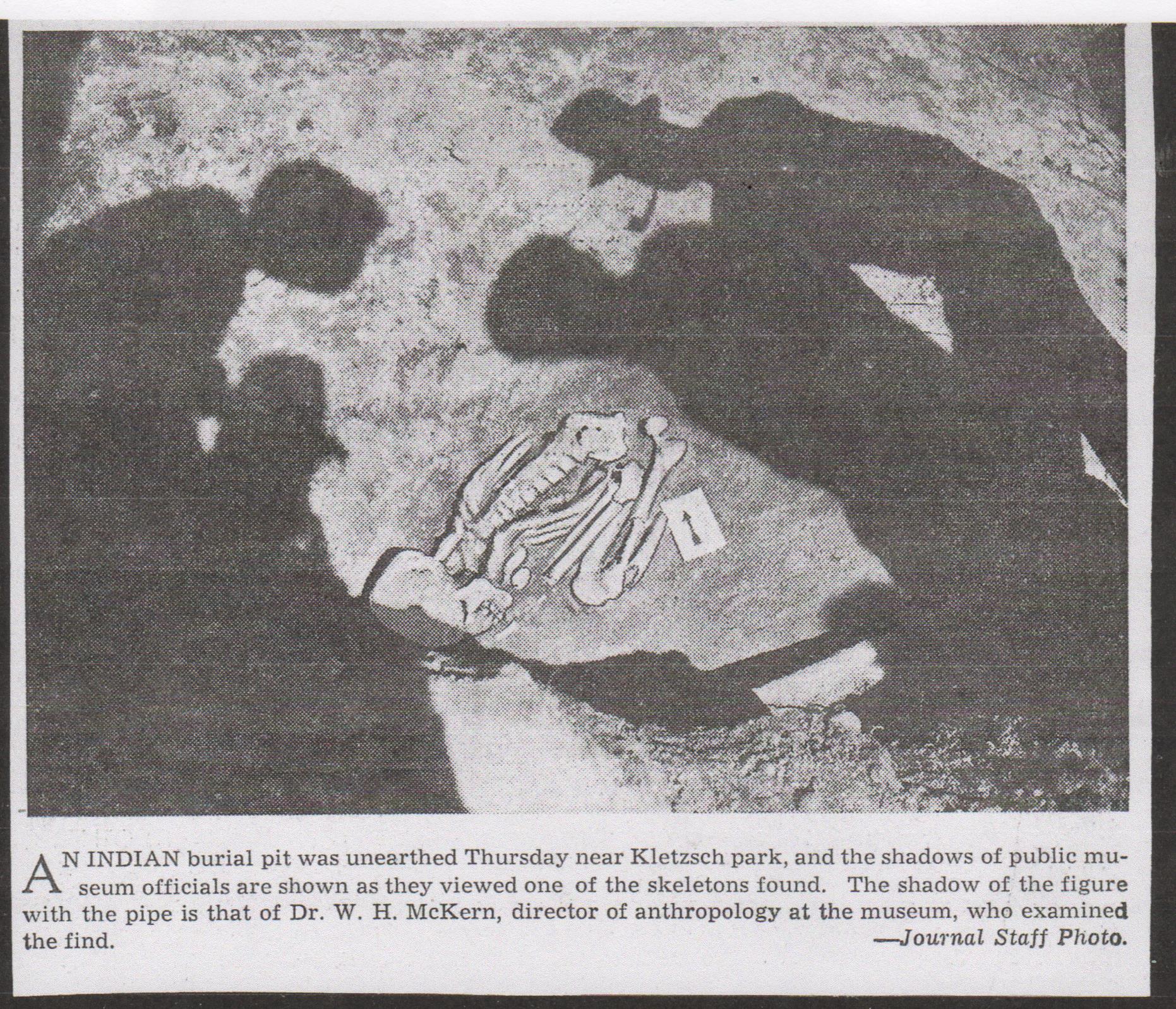 The
box ad lay between a charity’s plea for donated boats and cars and an
announcement of an open house for a senior apartment village. “Giant
Skeletons Found at Lake Lawn,” it declared, right there on page 9 of
the May 4, 2014 Walworth County Sunday. “Lake Lawn Hotel 1911.” The ad
continued: “In 1911 the Phillips brothers uncovered skeletons that
ranged from 7 to 9 feet! Author L.A. Marzulli is offering a $500 reward
for photographs of the dig site showing the skeletons, at the Lake Lawn
Hotel.” The mention of ancient, giant skeletons in my local
paper stopped me cold. I knew that a number of such remains had long
ago been disinterred from one or more of the 100-plus ancient conical
and effigy mounds built along the shores of Delavan Lake, Wisconsin.
This was before the structures were protected by law as sacred and
historic treasures. Now known as the Lake Lawn Lodge and Golf Course,
the popular resort is only about a 15-minute drive from my home. I’ve
been there many times and have researched the mounds and skeletons for
the “Ancient Mysteries” section of Weird Wisconsin. But I’d never found
any photos of the dig site, nor even a reference to such photos. None
of the original, 1911 newspaper stories on the discovery had provided
illustrations. If such photos existed, I was very eager to see them. The
Delavan Lake mounds were one of the largest and most important groups
of ancient earthworks in S.E. Wisconsin. They included both cone-shaped
mounds similar to those found across much of the country, and the rarer
animal-shaped effigy mounds. Archeologists often date cone-shaped
mounds to the Early to Middle Woodland cultures that flourished in
Wisconsin from about 500 BC to 500 AD. The animal-shaped effigy mounds
are thought to have been built by a later culture known as the Late
Woodland between approximately 500 AD and 1200 AD. (These dates and
identifications are still under study and involve complex interactions
between various prehistoric peoples; I recommend the book Indian Mounds
of Wisconsin by Robert Birmingham and Leslie Eisenberg for a more
thorough treatment.) Unfortunately, great numbers many of both
types of these mounds were leveled by early settlers in order to clear
the land for farming, houses, and even – from 1850 until almost the
turn of that century on Delavan Lake – winter quarters for members of
the Mabie’s Circus and Menagerie, complete with a ring barn for
training horses. Jeremiah Mabie owned the lakeside part of the
property, and after he died in 1867 his widow remarried. Anna
Mary Mabie Phillips and her second husband, Ernest Field Phillips,
built the original Lake Lawn Hotel on that beautiful shore in 1883. The
grounds still contained many of the original mounds at that time, but
treasure seekers had opened various of them without finding much. In
early March, 1911, the couple’s two sons, Ernest and Chester Phillips,
decided to see for themselves whether the conical mounds might indeed
contain burials and artifacts. They chose a 40-foot-diameter
mound behind the hotel’s horse barn, and soon uncovered a burial
chamber six feet below the top of the three-foot high mound. The
chamber measured about 7 by 9 feet, and its floor was made of carefully
layered gravel, white sand and blue clay. There was evidence that the
top of the chamber had been constructed of a one-foot thick layer of
dirt topped with fired clay. To the excitement of the Phillips
brothers, this mound did indeed contain burials: fourteen of them,
including several with fractured and otherwise damaged skulls that
indicated a violent death. Most of the bodies had been interred lying
on their backs with their knees flexed and arms bent upwards. But two
were buried in a sitting position. The only artifacts found (and these
were in the top of the mound, not the chamber) were a piece of flint,
an 8-inch sandstone “pebble,” and a 6-inch red stone. Ernest Phillips
submitted a full report of the findings to the Wisconsin Archaeological
Society on the 21st of that month. A little over a year later,
in 1912, the Phillips brothers decided to dig into another, similar
mound in the same area as the first. This burial contained one skeleton
in a sitting posture, a female and small child lying next to it, and
one other adult. The remains of a possible clamshell necklace was found
beneath the female burial. According to a later recap in the December,
1926 issue of The Wisconsin Archaeologist, the skulls of these burials
all had “low, flattened foreheads.” But that’s not all. This
second mound dig made national news very soon after its discovery. On
May 4, 1912, the New York Times carried an article from a May 3,
Madison, Wisconsin news article titled, “Strange Skeletons Found.” The
article ventured to state that the skeletons indicated “that a
heretofore unknown race of men once inhabited Southern Wisconsin.” (The
article then seems to combine the previously uncovered skeletons with
the four that had just been found to arrive at a total of 18, which it
describes without discrimination between the two mounds): “The
heads, presumably those of men, are much larger than the heads of any
race which inhabit America today. From directly over the eye sockets,
the head slopes straight back and the nasal bones protrude far above
the cheek bones. The jaw bones are long and pointed, bearing a minute
resemblance to the head of the monkey. The teeth in the front of the
jaw are regular molars. There were also found in the mounds the
skeletons, presumably of women, which had smaller heads, but were
similar in facial characteristics.” The Delavan Republican said,
“The skeletons appear to be those of warriors of powerful frame and
immense size when compared with people of this day and age.” The
Delavan Enterprise noted that “the cranium of one of [the] ancient
warriors was of unusual size, and the other bones found would indicate
that they were a race of giants.” The paper didn’t note the exact
height of these people, but similar skeletons estimated to be of the
same time period from around Wisconsin and the U.S. have noted their
heights at between seven and nine feet tall. Author Jim Brandon
mentioned a few of these in his 1983 book, The Rebirth of Pan. Beside
the Delavan Lake discoveries, Brandon included finds such as: Brewersville Indiana, 1879, skeleton measuring 9 feet, 8 inches taken from a mound Kanawha County, W. Virginia, 1844, skeleton seven and one half feet long taken from a mound chamber
Fox Lake, Illinois, (about 15 miles south of the WI/IL border) 1877
contained a skull similar to those described at the 2nd
Delavan dig: “The large projecting eye-brows, deep set eye sockets, the
low, receding forehead and the long-narrow and
flat shape of the crown
rendered it a very animal-looking skull.” (More examples may be
found online on a blog page titled Giant Human Skeletons at
http://gianthumanskeletons.blogspot.com/p/giant-skeletons-with-double-rows-of.html) So
who were these super-sized people with sloping heads and jutting chins?
They probably weren’t the Algonquian, Winnebago, Sac and Fox people
encountered by European settlers in the late 1700s and early 1800s, who
were mostly under six feet tall and lacked the exotic skull features of
those buried in the two mounds. Estimates of the age of the mounds and
bones ranged as far back as 2000 years, and most traditional
anthropologists would align these large people with the mound-building
groups dubbed the Adena and Hopewell. The Adena people had some
rather unique and recognizable features, according to an article in
March, 1985 FATE Magazine by Jim Miles. He quotes Carnegie Museum
curator Don W. Dragoo to note that the Adena were distinguished both by
body heights over six feet in height with “massiveness of the bones
[that] indicates powerfully built individuals,” and by “a massive
protruding chin.” Dragoo’s study was based on almost 100 skeletons
found in Kentucky, Ohio, and West Virginia. BeaverDamDig 001Some
similar individuals may have been buried just north of Milwaukee and
other points around Wisconsin. Beaver Dam’s terrific Dodge County
Historical Society Museum displays photos from excavations made a few
miles east of town in their Nitschke Mound Park. The skeletons in these
photos don’t appear unusual. However, on a recent visit some friends
and I were allowed to look through the files, where I found an old
newspaper clipping of a burial dig from The Milwaukee Journal, date
unknown. This one (see scan, left, of the copy the museum made for me
of the newspaper clip) revealed a skeleton with a truly strange,
enlarged and weirdly shaped skull that was unearthed in Kletzsch Park
along the Milwaukee River, probably in the 1930s. The photo includes
the silhouette of a director of anthropology at the Milwaukee Public
Museum, W.H. McKern. Researchers have proposed many theories as
to the origins of these large people. Author Marzulli believes that
some of these skeletons may have belonged to a dispersed remnant of the
people referred to in the Old Testament chapter 6 (verses 1-4) of
Genesis as the Nephilim – offspring of the “Sons of god and daughters
of men.” One key element Marzulli points to is that so many of these
skulls feature cranial elongations and oddities that cannot be
explained by normal variations of human physiology nor by
skull-flattening practices some native peoples employed to reshape
their infant children’s skulls. These anomalous skulls with huge and
weirdly shaped craniums are widespread throughout the Americas, with a
particularly large number found in Peru. Some researchers
believe the skeletons are those of extraterrestrial aliens or even
Bigfoot, and I have to admit that the description of those massive
skulls with giant eye sockets and flattened foreheads does remind me of
witness descriptions of Sasquatch. Others believe that the Sasquatch
are the remnants of the Nephilim, and that the Nephilim were
extraterrestrials. The traditional anthropologist’s answer,
usually, is that these were simply very robust indigenous people or
individuals with either naturally inherited stature or growth hormone
problems. Various medical conditions that contribute to giantism do
exist today. Robert Wadlow of Alton, Illinois who grew to a height of 8
feet, 11 ½ inches, needed a 10-foot casket after he died in 1940 at age
22. But photos of Wadlow show him with a very normally (according to
our own Western, modern standards) shaped head. It seems these skeletons represent a true mystery. I
called the Delavan Historical Society to see if by chance they had some
shots of the digs in their collection, thinking that if they did, they
might want to go collect the reward. Small-town historical societies
can always use extra funds. They did know about the offer – Marzulli
had already visited them in person – but alas, they had found nothing
for him. One of the staffers gave me the name and phone number of the
elderly daughter of a former owner of the property back in the mid-20th
Century, however, on the chance that such photos may have been handed
down within her family. The very kind lady wasn’t sure, but invited me
to have a look through her father’s old family photo albums. That visit
was a story in itself, but yielded no dig photos. It wouldn’t
surprise me if nothing conclusive about these mounds ever comes to
light. For some reason, any evidence of the remains of anomalous
human beings seem to disappear into a deep, black hole of obfuscation
once any sort of established institution gets access to them. Even in
1983, Jim Brandon said of the anomalous bones found in ancient North
American mounds: “As soon as mound excavations became widespread in the
19th Century, these reports began to circulate. It is doubtful,
however, if any topic has been more relentlessly suppressed.” Part
of the reason for that, of course, is the completely understandable
outrage that Native Americans feel at seeing burials sacred to them dug
up and displayed for all to see. Almost all museums and other
institutions that have harbored remains of Native Americans have by now
repatriated their collections to the appropriate tribal entities. But
beyond that, there seems to be an extra wall of silence regarding the
existence of these huge skeletons with the unusual skulls. I do
know, thanks to a 2004 interview I conducted with the late Delavan
historian, Gordon Yadon, that two of the largest Delavan Lake skeletons
were removed from the mound and taken to a house the Phillips brothers
owned in town. The brothers, Yadon told me, coated the bones with
shellac to preserve them. After both brothers died, their belongings
were auctioned off but the skeletons weren’t part of the sale, said
Yadon. No one knows where they went. Or if anyone does, they aren’t
talking. I presume any alleged photos disappeared with the skeletons. Some
later excavations were made of a turtle mound and a linear mound at the
resort in November, 1955, by representatives of the Campus
Archaeological Society of the University of Chicago. This dig was
duly photographed and recorded, and from what I could discover revealed
only the more usual contents of Woodland-era burials, including a few
skeletons “bundled” in the traditional manner of many Native American
cultures. It’s possible that some of the remaining mounds still
hide secrets from prying, modern eyes, and if so they will remain
hidden thanks to our present laws governing preservation of such sites.
If it’s any comfort, I’m sure that’s what their makers intended. Sources: “Startling and Important Discovery,” The Delavan Republican, March 23, 1911, p. 1. “Scene of Old Battle,” The Delavan Enterprise, March 23, 1911, p. 1. “Strange Skeletons Found,” The New York Times, May 4, 1912. “The Legend of Lake Lawn Lodge,” 2001 Visitor Information Guide, (publisher uncertain) pp. 40-41. “The Legend of Lake Lawn Lodge, Delavan, Wisconsin,” Ruby Reader, resort pamphlet citing the Walworth County Historical Society “Phillips Brothers Excavated Indian Mounds,” W. Gordon Yadon, Delavan Enterprise, Jan. 22, 2004. Jim Brandon, The Rebirth of Pan; Hidden Faces of the American Earth Spirit, Dunlap, Ill.: Firebird Press, 1983, p. 243-246. Birmingham and Eisenberg, Indian Mounds of Wisconsin, Madison, Wis.: The University Press, 2000. Source: Linda Godfrey Blog http://lindagodfrey.com/2014/10/03/ancient-giants-of-delavan-lake/
-
GHOSTLY TALES IN YOUR TOWN DEPARTMENT -
Spooky Sights, Sounds
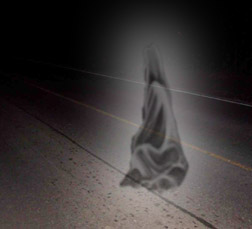
Glenn Wershing says he believed his house in New Jersey was haunted the
moment he moved in with his wife and three children in 1961.
"On the third floor, we would hear footsteps going from the back of the
house to the front of the house, then a big thump," Mr. Wershing
explains. "I think I must have run upstairs a hundred times with a
flashlight to see who or what was there, but I never found anything."
Mr. Wershing, 76, and his wife, Jackie Wershing, 71, live in the Thomas
P. Hunt house, a three-story farmhouse built in 1835 that runs along
Bear Creek, which adjoins the property.
The couple has noted numerous incidents that suggest the lingering
presence of a ghost or some unearthly being. One Christmas, for example,
Mrs. Wershing took a photo of her three children around the living-room
Christmas tree. When the photo was developed, it appeared that the
dismal figures of three other children — in shadowy form — were present,
as well.
The couple is among the 40 percent of Americans who believe that a
place can be haunted. According to a Gallup poll in 2001, this
percentage is up from about 29 percent 10 years earlier.
"You never know when these weird things will start happening, but the
change in seasons is usually a good indication" Mrs. Wershing said. "It
was bitter cold one night, and I awoke at about five in the morning.
There, standing in front of Glenn's dresser was a lady with extremely
long hair, wearing a nightgown of some sort. I just barely opened my
eyelids, straining to try and see a face, but absolutely nothing was
reflected in our bedroom mirror."
Mr. Wershing suggests that the people who lived in the house prior to
them just weren't ready to go yet: "It wasn't like there was a murder
here or anything like that. Years ago, it was commonplace for people to
die in their homes. I've said I don't believe in ghosts, but something
is happening in this house."
The Wershing household is one of dozens of eerie phenomena compiled in
"Weird U.S.: Your Travel Guide to America's Local Legends and Best Kept
Secrets." The new book collects tales of the unexplained from across the
country — including such Washington-area legends as the Goatman and
"Crybaby Bridge."
Joe Nickell, investigative columnist for the Skeptical Inquirer, says
this belief in the paranormal taps into the hopes and fears of the
American people.
"Psychic power lets us look into the future, aliens and UFOs reassure
us that we are not alone in this universe, and ghosts give us the
message that there's something to look forward to after death," Mr.
Nickell said. "There's no objective or scientific evidence for ghosts.
I've come to believe that it's not the places that are haunted. It's the
minds of the people."
Haunted sites like the Martha Washington Inn in Abingdon, Va., however,
continue to attract ghost-believing visitors each year, asking about the
haunted history of the Inn, and the supposed ghost of a young nurse
named Beth who haunts the Inn's premises. Pete Sheffey, a bellman at the
inn, claims to have seen a lot of strange things throughout his 40 years
of employment there.
"Our guests sometimes hear the sound of violins coming from the upper
floors, but there is no one playing," said Mr. Sheffey, 63. "This is the
ghost of Beth, who lived here during the Civil War, when the inn was a
hospital. Last week, one guest saw [Beth's] feet moving down the hall
... then, they just vanished right in front of her. Some guests don't
believe in the ghost stuff when they arrive, but by the time they leave,
they do."
D.C. resident Steve Cupo, 50, said he had his own personal encounter
with a ghost sighting. Mr. Cupo was a lead actor in "Give My Regards to
Broadway" at the Circuit 21 Dinner Theatre in Rock Island, Ill., in 1981
when he saw the ghost of a deceased janitor sitting in the balcony.
"It was during rehearsal, and I had just run up to a very high platform
on the stage," Mr. Cupo said. "We had to stop the performance for some
reason, and as I was glancing around the auditorium, I saw a strange
Portuguese man in overalls sitting in the balcony. I looked away for a
minute, but as soon as I looked back, he was gone. One week later,
people were talking about this ghost of a Portuguese janitor, who
accidentally killed himself in the theatre in 1922, and now he haunts
the place."
"Weird U.S." also highlights stories of "bizarre beasts," including the
infamous Goatman of Prince George's County.
The Goatman is described as a half-man, half-goat creature, whom local
lore blames for attacking cars left near the road and throwing dogs off
Interstate 495 overpasses near secluded areas.
Since the late 1950s, the Goatman has left his mark on the front page
of two issues of the Prince George's County News. The Nov. 10, 1971,
edition carried a front-page banner declaring "Residents Fear Goatman
Lives: Dog Found Decapitated in Old Bowie" with a photo of the remains
of the mutilated pet. The canine victim's owners reportedly had heard
strange noises and saw an "animal-like creature" moving in the dark
right before the dog disappeared.
According to some area residents, the Goatman lives near a notorious
Prince George's County site, Crybaby Bridge in Upper Marlboro.
At Crybaby Bridge, passing motorists say they have heard either the
shrill cry of an infant ghost — local legend says it's the spirit of a
baby who was thrown over the bridge by her ashamed, murderous mother —
or the Goatman, stealthily awaiting his next victim.
Mark Moran, co-author of "Weird U.S.," said he and co-author Mark
Sceurman took about a year to travel nationwide to investigate and
research these, and many other, haunted places nationwide, many of which
were "tips" from readers. After they published "Weird NJ" — a
compilation of spooky tales from New Jersey — in 2003, the authors began
receiving letters from across the country, telling them strange tales
from their home states.
"What we do is listen to what people tell us is weird about their own
hometown," Mr. Moran said. "I don't know if these stories are fact or
fiction, but what I do believe is that the people who tell us their
story truly believe it."
Source: The Washington Times
http://washingtontimes.com/culture/20041026-115155-2248r.htm
- ANCIENT TECHNOLOGIES DEPARTMENT -
Ancient Egypt Illuminated by Electricity?
By Paul Darin
 Today,
we take for granted nightly city skylines, streetlights, and the
overall power that drives our modern convenience. But, could the
wise-men of ancient Egypt and Mesopotamia have had knowledge of
electricity, even electric illumination, or even electric-based
technology? Within the framework of some archaeological evidence, the
answer seems affirmative. The most widely cited evidence that
the ancient Egyptians used electricity is a relief beneath the Temple
of Hathor at Dendera, Egypt that depicts figures standing around a
large light-bulb-like object. An Ancient Light Bulb? The
socket is represented by what appears to be a lotus flower with a stem
that runs like a cable along the bottom of the “device.” Inside the
“bulb” is a snake-like line winding its way out of the lotus flower
“socket.” According to supporters of the hypothesis that this depicts
an electrical light, such as Erich Von Däniken who wrote “Chariot of
the Gods,” the snake represents the filament of the bulb. Von
Däniken created a working model of the bulb in the laboratory which
works, emitting an eerie, purplish light. He used the same
measurements, including two metal beams that look like arms stretched
into the big end of the bulb, and a wire connecting those beams with
the “socket” at the other end. But where did the power come from to light the bulb in ancient Egypt? An Ancient Battery? An
artifact found a ways away from Egypt, outside of modern-day Baghdad,
shows some electricity production was possible in the Middle East
thousands of years ago. This artifact is known as the Baghdad Battery. The
Baghdad Battery is simple in comparison with today’s batteries. It
consists of a clay jar with a stopper made of asphalt. Through the
stopper is an iron rod surrounded by a copper cylinder. It is believed
that the jar would have been filled with a common acidic substance such
as vinegar that would allow it to produce about 1.1 volts of
electricity. Replicas of the battery have shown it works. 1.1
volts may not seem like much, but if you string several of these
batteries together, the voltage increases. The battery was dated from
250 B.C. to 250 A.D. The current belief is that these batteries were
used in early electroplating (bonding a layer of one type of metal onto
the surface of another). These batteries aren’t the only
theoretical power source. Some claim that one of the most iconic
structures in Egypt is in fact the most misunderstood device on the
planet. Specifically, supporters of the ancient Egyptian electricity
hypothesis say the Great Pyramid of Giza was actually used as a power
plant. An Ancient Power Plant? This idea was first
championed by author and researcher Christopher Dunn in his books “The
Giza Power Plant” and “Lost Technologies of Ancient Egypt.” Dunn
said the “Kings Chamber” located in the heart of the Great Pyramid was
once the central power generating apparatus of the super structure. It
is constructed primarily of pink granite, a material rich in
micro-quartz-crystals. In fact, the Great Pyramid is mostly
granite, and granite is made up of many tiny quartz crystals that, when
exposed to pressure and/or energy vibrations, generate electricity.
This is known in the scientific community as the piezoelectric effect.
This effect is used in many modern technologies, such as loud speakers,
signal transducers, and it has some applications in the automotive
industry. According to Dunn and other supporters of this theory,
the granite sarcophagus in the King’s Chamber (also intricately carved
in solid pink granite) could have been instrumental in transmuting the
low-frequency vibrations emitted by the earth into electrical energy.
Additionally, Dunn said, the supporting beams in the ceiling of the
king’s chamber all seem to have been precisely tuned, or cut to size,
to perfectly resonate with this frequency. Source: Epoch Times http://www.theepochtimes.com/n3/996220-ancient-egypt-illuminated-by-electricity/h
- DENIZENS OF THE DEEP DEPARTMENT -
Meet Issie, Japan’s Very Own Loch Ness Monster
By Jessica Kozuka
 You
may have thought that the Loch Ness Monster had cornered the market on
fresh-water cryptids, but Japan has one of its own mythical lake
beasts. There may be a monster lurking in the depths of Kyushu’s Lake
Ikeda, a monster who goes by the terrifying name of… Issie-kun. Lake
Ikeda, at just 15 km around and with a maximum depth of 233 meters, is
still the largest lake in Kyushu, which just goes to show that there
are not that many lakes in Kyushu. It’s a caldera lake, meaning it
doesn’t connect to the ocean and depends mostly on precipitation to
maintain water levels. The lake is supposedly also the home of a
huge saurian creature called Issie, or Issie-kun, to give him the
diminutive male suffix the city seems to prefer. Issie was first
spotted by a family in 1978. Twenty witnesses reported seeing some
black humps several meters in length moving through the water. Later
that same year, a man named Toshiaki Matsuhara caught the creature on
film. Yutaka Kawaji and Hideo Kawaji may share the same surname,
but they also share the same phenomenal experience. You see, they are
both witnesses to the Japanese lake cryptid know as Issie, said to
inhabit the depths of Lake Ikeda in Japan. What is remarkable is
that they both saw the creature when they were elementary school
students and also later in life. In fact, Yutaka Kawaji actually
witnessed the creature on three occasions and two of the sightings
occurred in the same year. In the spring of 1978 Yutaka saw the
creature from a garden. Details of this sighting are very sketchy and
we know little else than that he saw an unknown creature in the lake. It
is the sighting on September 3, 1978 that is the best known sighting in
the history of the Lake Ikeda enigma. This sighting was not witnessed
by just a handful of people but by 20 people, virtually all related to
Yutaka Kawaji. Kawaji’s children Hiroto, Mutsumi and Tomoko were
playing by the lakeshore when they noticed two humps belonging to a
large black creature gilding through the waters of the lake which is
set in the caldera of an extinct volcano. These were big humps
measuring five metres (16.26 feet long) and standing some 60
centimetres (two feet) out of the water. The children alerted the
adults in the party to the presence of the creature and before anyone
had time to breathe, Yukata Kawaji leapt aboard a motorboat and pursued
the creature as it crossed the lake at a fair clip. Kawaji was
unable to catch up with the creature but during a sighting that lasted
three to four minutes, he was able to see the humps twice for about 20
seconds. Conditions on the lake were mirror smooth with no wind or
waves to speak of. The witnesses agreed that the only activity on the
lake came from the immediate area where the cryptid had made it
appearance. Yutaka Kawaji was so enthralled by his sighting that
he purchased a camera with a 135 millimetre lens in the hope that some
day he would be able to photograph the creature. Kawaji has never seen
the creature again, but as chance would have it, the mystery denizen of
Lake Ikeda was photographed on December 16, that year and that honour
would fall to Toshiaki Matsuhara. Matsuhara was interested in the
folklore and legends of the lake, and this included the legend of Issie. It
was one thirty in the afternoon that day when Matsuhara saw a whirlpool
suddenly appear in the middle of the lake. For five minutes he watched
it through a 50X telescope as it moved northward for five minutes
before it disappeared. While scanning the lake in the aftermath
of his initial sighting Matsuhara’s attention was drawn to an object
moving in the lake which was somewhat veiled by waves surrounding it.
He quickly took a series of photographs and in one of them what appear
to be two humps with spinal ridges can be seen. By this time the
tourism department of the nearby city of Ibusuki had offered a reward
of 100,000 Yen ($670) to anyone who could produce a photo of
Issie. Matsuhara submitted his photo for their consideration and the
tourism department officials were impressed enough to award Matsuhara
the prize money. When the photos were published, they struck a chord in
the recollection of Yutaka Kawaji who promptly contacted the tourism
department to say the Matsuhara had photographed the creature he had
seen three months earlier and that it was also in the exact same
location off a local landmark known as the Couple’s Rock. Incredibly
Matsuhara is alleged to have photographed the creature on four more
occasions, but few have seen these photos and they have not been
submitted for serious scrutiny. Lake Ikeda is a remarkable place
as it receives its water from rain and subsurface water sources. There
no rivers or streams that flow into the lake. This is quite problematic
in that it begs the question: How did a creature the size of Issie get
into the lake? The only possible way it did so is to have entered
through a subsurface opening, but the question is: from where? The
Lake is situated on the Satsuma Peninsula that is bordered on one side
by the Sea of Japan and on the other by the Gulf of Kagoshima. It is
quite a distance from the sea and because the lake is also above sea
level, it is highly unlikely that it came from the ocean. At some stage
in its history large Malaysian eels were introduced to the lake and
these fish are farmed commercially on the lakeshore. I thought they
might make a good candidate for Issie sightings , but I discovered that
the largest eel ever seen in the lake – incidentally in the same area
where Matsuhara and Kawaji had their sightings – was just 1.7 metres at
most. This is far too small to be even one of the five meter
humps. Even the large snapping turtle that has been photographed in the
lake is far too small to account for the large creature that many
insists is Issie. In 1991 a videotape of Issie was made and shown on the Nippon TV special World’s Mysterious Phenomena. Since
then, the tourism authorities have been promoting the Issie story to
attract visitors to the region. There is even a mythology to explain
Issie’s creation. In the story, a white mare lived on the shores of the
lake with her foal. When the foal was captured by samurai, the white
mare leapt into the lake in despair, transforming into a huge water
creature. She surfaces now and then to look for her child. There is no
explanation as to why Issie is a female in the story, but the monster
is generally considered male. Another mystery! On a completely
unrelated note, Lake Ikeda is home to giant eels, some of the largest
in the world. They can grow to several meters in length. I’m sure the
resemblance to Issie is purely coincidental. Source: Rocket News http://en.rocketnews24.com/2014/09/30/meet-issie-japans-very-own-loch-ness-monster/
Sign
up today for Bizarre Bazaar and Conspiracy
Journal Magazines
|
















